The Aerion company announced its cessation of operations.
(CNN) -
The long-awaited dream of a Concorde successor has drifted a bit further, as one of the main contenders in the race to build a supersonic passenger jet appears to have run out of financial fuel.
Reno, Nevada-based Aerion has been developing the AS2, an 8 to 12 passenger business jet capable of flying at 1,600 km / h.
However, the company announced on May 21 that "in the current financial environment it has been a great challenge to meet the large capital needs anticipated and required to complete the transition from AS2 to production."
And it added that, "given these conditions, Aerion Corporation is taking the appropriate measures taking into account this current financial environment."
American aircraft manufacturer Aerion was building a new headquarters and campus in Florida to produce its AS2 supersonic jet.
Courtesy: Aerion
It's a colossal disappointment for business travelers hoping to fly supersonic in the near future.
What makes all this so shocking is that the AS2 was already in an advanced stage of development, having recently concluded high-speed wind tunnel tests, accumulating hundreds of flight hours, the equivalent of 144,456 kilometers of flight, at the French aerospace test laboratory ONERA in Modane, France.
The development of the AS2 was conceived as a totally carbon neutral effort, so Aerion used digital modeling techniques to save fuel and 'negate the need for expensive demonstration aircraft and accelerate the program to the final stages of validation. before production '. Actual manufacturing had been scheduled for 2023, with a plan to build 300 aircraft in a decade.
The AS2, Aerion said in an official statement, “meets all market, technical, regulatory and sustainability requirements, and the market for a new supersonic segment of general aviation has been validated with a sales portfolio of US $ 11,200. millions".
The company also had the backing of Boeing, although America's largest aircraft maker currently has its own challenges, including its problems with the 737 MAX.
This January, CNN Travel reported preparations for Aerion's new headquarters, Aerion Park, in Florida, designed to combine the company's operations with a campus for the research, design, construction and maintenance of the company's aircraft. company.
advertising
Ambitious plans for the Aerion AS3 were revealed in March 2021.
Courtesy: Aerion
A setback for the upscale clientele
All of this is certainly discouraging for the clientele of the luxury jet operator Flexjet, the AS2's main customer, who surely expected to experience the thrill of breaking the sound barrier while saving valuable minutes on business trips.
However, Flexjet president Kenn Ricci seems to take the news philosophically:
"Flexjet ordered its AS2s from Aerion Supersonic in 2015 and the company has supported the program ever since," he says.
"While we are disappointed by the news that the company is ceasing operations, we understand the enormous investment these programs require to carry them out and the inherent risks they carry."
Supersonic Competitors Keep Going
Meanwhile, Denver, Colorado-based Boom Supersonic is continuing its plans for its 65- to 88-passenger Overture aircraft, primarily intended for transoceanic routes and operating at more than twice the speed of sound.
This would reduce the route from New York to London to just three hours and 15 minutes.
The aircraft's test prototype, the XB-1, will be 100% carbon neutral, according to the company, and is expected to make its maiden flight later this year in Mojave, California.
If all goes according to plan, the Overture is scheduled to fly in 2026 and begin commercial operations in 2029.
The program has been supported by Japan Airlines with a strategic investment of US $ 10 million and the option to purchase up to 20 Boom aircraft through a pre-order agreement.
Other sponsors are Bessemer Venture Partners, Prime Movers Lab, and American Express Ventures.
On the other hand, Spike Aerospace, based in Boston, says it is collaborating with Tech Mahindra, a specialist in composite aerostructure design, stress analysis and optimization, on the development of the low-thrust Spike S-512 Supersonic Jet, which "Will fly 12-18 passengers in quiet luxury at Mach 1.6".
An exclusive look inside the US supersonic presidential jet.
In the longer term, another supersonic company, Exosonic, is building a Mach 1.8 presidential jet with a range of 9,260 kilometers, equipped with fancy gadgets.
However, White House incumbents will have to wait until the mid-2030s for this "Air Force Two" to take to the skies.
Paperwork and formalities
But one question looming over the aspiration to travel in supersonic is: to what extent can time be saved by considering all the elements of the entire door-to-door journey, now that the additional time-consuming sanitary procedures are included in The airports?
The latest IATA results confirm that, during peak hours, waiting times at airports have doubled compared to pre-covid trips, while the volume of traffic is still only 30 percent of those. levels prior to covid-19.
The largest increases, according to IATA, are in check-in and border control (emigration and immigration), where travel health credentials are mainly checked as paper documents.
The models suggest that, “without process improvements, the time invested in airport processes could reach 5.5 hours per trip at traffic levels of 75% before COVID-19, and 8.0 hours per trip at levels 100% traffic before covid-19 ».
In the new era of ever-changing entry requirements, testing and quarantine rules, despite attempts to help passengers seamlessly collect and display their health information at airport checkpoints using 'vaccine passports ». What is really emerging is a mosaic of digital options.
So far, of the 247 airlines operating international scheduled services, 32 appear to have adhered to the IATA Travel Pass, while other similar initiatives, such as the American Trusted Traveler program, IBM's Digital Health Pass, the World Economic Forum CommonPass and Ryanair's Travel Wallet (a companion to the company's reservations app) compete for passenger health data.
But with all these solutions, a unified and coordinated connection with the broader travel environment, such as ground transportation, hotels, restaurants, shops and leisure venues, will be necessary so that the traveler can optimize their trip once they reach your destination.
The journey from start to finish
The IATA findings now mean that the air segment of the journey is just the central component in what is turning out to be a longer ordeal.
"Passengers, both business and leisure, are increasingly aware of the notion of travel time and not just flight time," Iain Gray, director of aeronautical engineering at Cranfield University, told CNN Travel.
Early in his career, Gray led the European international team for what was called the European Supersonic Research Program, which worked on the design of the successor to the Concorde.
“We were working with the Russians, the Japanese, the Americans and the Europeans on the possible replacement for the Concorde, an international effort at the time, and we put a lot of effort into the 'rate elasticity model', looking at the price premium that people would pay for the benefit of flying supersonic.
Gray's team found that only a small number of people "would pay a ton of money for the privilege of reducing flight time."
And today, the high cost of supersonic flight is not the only obstacle, as increasingly stringent environmental targets come into play.
"The challenges around the environment increase with each passing year, so every time supersonic technology catches up with today's environmental goals, the goals have shifted," says Gray.
He points out that, even when flying over water, new supersonic aircraft manufacturers will have to take into account aspects such as the impact of sonic booms on marine life, in addition to taking into account CO2 and acoustic disturbances for human populations when flying. on land.
But Gray also points out that the economics of aviation can also change dramatically.
"People would not have imagined 25 years ago that low-cost subsonic companies could offer rates cheaper than the cost of parking the car at the airport," he says.
“So it's silly to say that [affordable] supersonic flights will never happen, but at the moment the challenges are increasing.
The technical solutions are there, but they are expensive.
Travel is back, just like travel scams
A long-term game
Meanwhile, the economy is of course also a challenge for aviation today, not to mention tomorrow's, as global passenger numbers are not expected to rebound to pre-covid levels until 2023. .
And conventional flights are going to be more expensive, at least as long as physical distancing, less frequent flight times and additional airport procedures remain the norm.
Assuming that health checks could become a long-term (if not permanent) feature of air travel, as well as additional security measures after 9/11, the time-saving benefits of supersonic flights should be further analyzed.
'Travel is on the mend.
However, the highly profitable business travel segment is slower than leisure travel, "John Schmidt, director of aerospace and defense at Accenture, told CNN Travel.
“Future levels of business travel are still unknown, but needs may be different, and demand will emerge over a period of years. Business travelers have always valued speed and the ability to land at the destination and be immediately productive, whether with business jets or more comfortable experiences on commercial aircraft. Supersonic planes are built on that desire and courage.
Schmidt adds that, even with a stronger vision of sustainability, “aircraft developers seem to be accepting that challenge, as they are able to work from clean designs.
This is a long-term game, with planes that are expected to be certified in the late 2020s and 2030s, so it is undoubtedly a big bet, as aircraft developers are betting on the desire to of the business traveler to be fast and the ability to get to the ground remain intact ».
"That," he concludes, "has fueled innovation in business jets and commercial aviation offerings for the past few decades, and there doesn't seem to be a reason why our current travel hiatus will change that in the long run."
Approaching the sound barrier
As the remaining jetsonic competitors struggle to bring faster jets to market, private jet operators are doing their best to satisfy the appetite for speed of business travelers with jets that get as close to the sound barrier as possible. without breaking it, which raises all kinds of environmental problems.
"There is no question that supersonic and hypersonic aircraft will change the landscape of aviation once they are available to the public," Ian Moore, VistaJet's chief commercial officer, tells CNN Travel.
A private suite aboard the Global 7500.
Courtesy: Bombardie
Malta-based VistaJet, which offers access to private jets on a 'tailor-made flight hours subscription plan', has been increasing its fleet of Bombardier Global 7500 aircraft, which are capable of reaching a maximum speed of 852 kilometers per hour, or Mach 0.925, practically the fastest subsonic speed at which a plane can fly.
“We will continue to invest in our infrastructure and global fleet.
In early April, VistaJet received the Global 7500, being the first to offer this pioneering aircraft to the commercial market, with more to come later this year, ”says Moore.
He adds, “The Bombardier Global 7500 is a game changer with its record speed, industry-leading range, and jet lag-reducing features.
Until now, there has been no speed increase in travel times since the Jet Age of the 1950s and 1960s.
- Paul Sillers is an aviation journalist specializing in the passenger experience and air travel technology of the future. Follow him on @paulsillers
Supersonic aviation














